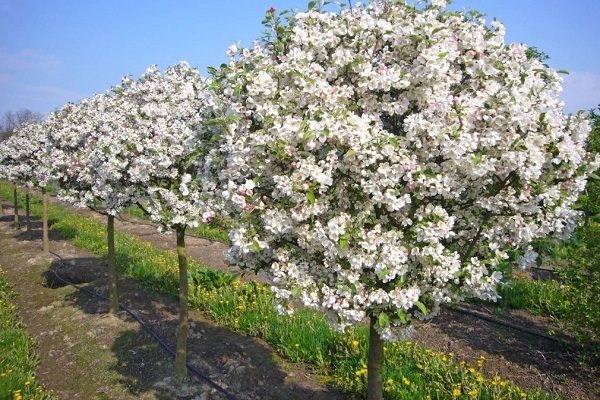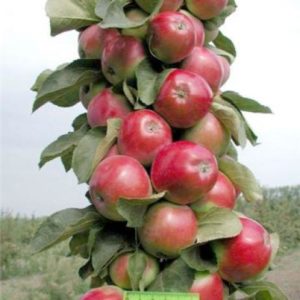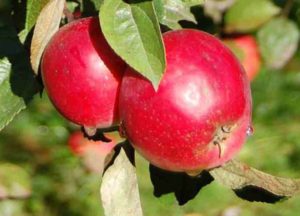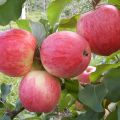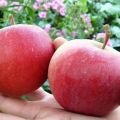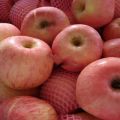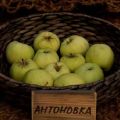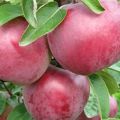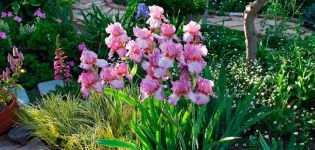Care rules and planting scheme for semi-dwarf apple trees, their cultivation and regions of distribution
Recently, semi-dwarf apple varieties have become especially popular. This is a variety of apple trees that has an average height. Thanks to this, space is saved in the garden, and fruit harvesting is much easier. But caring for such trees has its own difficulties. They react negatively to bad conditions and die quickly. Such apple trees live no more than 15 years.
Description and characteristics of the species
The height of the semi-dwarf is about three to four meters, and the volume of the crown is no more than two. This allows them to be planted more densely than regular apple trees.

Despite its compactness, the semi-dwarf gives rather high yields. Some varieties, with proper care, can yield up to 50 kg of apples per tree.
To obtain this type of apple tree, an ordinary apple tree is grafted onto a special stock. Apple trees grown from seeds or vegetatively are used as a stock. To obtain a semi-dwarf tree, they are grafted onto a stock M-9 or MM-106.
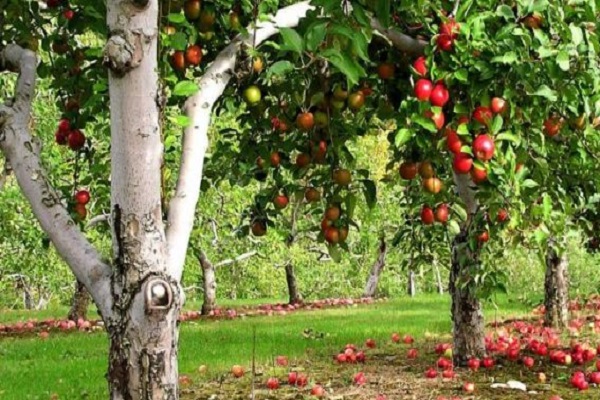
Pros and cons of semi-dwarf apple trees
The varieties have their advantages and disadvantages. The advantages, thanks to which summer residents choose this type of apple trees, are as follows:
- Semi-dwarfs give their first harvest in the third year after planting in a permanent place.
- The size of the trees allows harvesting without the use of tall ladders. There is also no problem cleaning trees in spring.
- If you use a vegetative stock, you can get high quality fruits. You can also choose a stock that has a high frost resistance. This will give the same qualities to the future tree.
- Can be grown in small garden areas and in areas where there is little free space, such as at home or near a fence.
- Low-growing varieties are not afraid of groundwater, because they have a small root system.
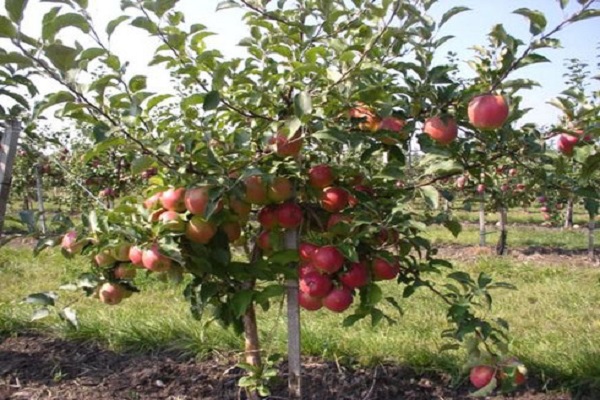
The disadvantages include the size of the roots of this culture. They are underdeveloped, which creates additional problems. In severe drought, the tree may lack moisture and it will dry out. In winter, the root system can suffer from frost, and in rainy weather, with strong winds, the apple tree can fall to one side. Therefore, such trees do not live long, their life expectancy depends on proper care.
Popular varieties
Modern breeders have bred many varieties of semi-dwarf apple trees. The most popular among gardeners were:
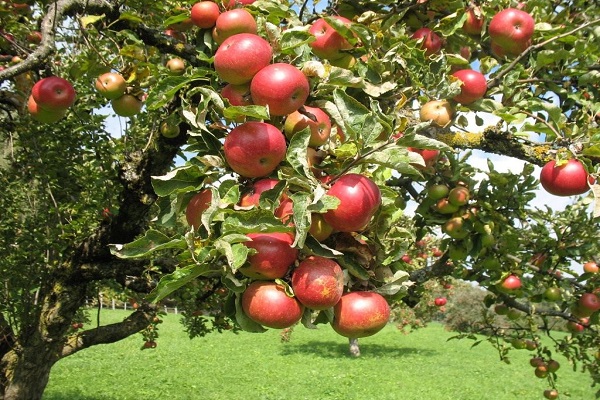
- Lobo. This variety quickly begins to bear fruit and produces tasty juicy apples that are large enough. Fruits can reach 200 g.
- Melba.The variety is quite common and appreciated for its juicy and sweet fruits. But not suitable for long-term storage, it ripens in summer.
- Antonovka. The variety is quite winter hardy and suitable for growing in the northern zone. Produces high yields and can live longer than other varieties.
- Imrus. Apple trees are resistant to diseases, apples are large and juicy. Winter variety, ripens in autumn and stays well until spring.
Each of these varieties has its own valuable qualities. Many smallholder gardeners choose to plant multiple varieties of trees at once to have fresh apples all year round. Large entrepreneurs plant varieties in gardens that bear fruit faster, live longer and tolerate transportation well. Winter varieties are more suitable for this, they can lie until next summer.
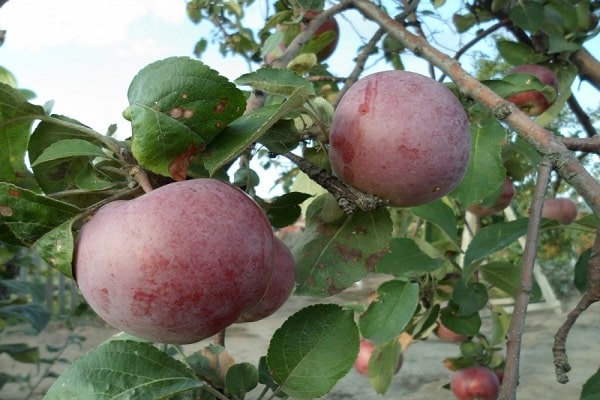
Planting and care rules
Planting and caring for semi-dwarf apple trees has its own characteristics:
- This culture does not like salty soil, so it should be planted in good black soil, sandstone or loamy soils.
- The seedling is planted in a hole, where a little fertilizer was previously poured. For this, you can use chemical or natural products. But you can't overdo it. A lot of fertilizer can ruin the root system. It is better to mix them well with earth and sand so that there are no lumps.
- Together with the seedling, a small peg is buried in the hole, to which a young apple tree is tied. This is done so that the trunk does not tilt over time, and an even tree grows from the seedling.
- The tree in the hole is positioned so that the root collar remains open above the ground. The roots should be spread over the entire fossa, without kinks. The ground above the roots needs to be tamped a little.
- The planting pattern for a seedling is slightly different from planting a regular fruit tree. The distance between trees is less than that of tall trees. For good growth, 2 m is enough for them, and the row spacing is 3 m. It is not worth thickening more strongly, this will affect the size of the fruits and yield.
- The trees are planted in early spring and watered periodically throughout the summer. Top dressing is regularly applied. Be sure to remove weeds and loosen the soil around the tree. They carry out treatment against pests and diseases.
- In the spring, cut off excess branches and cleaned of dried and damaged branches. The place where a large branch is cut is treated with a special compound or diluted lime.
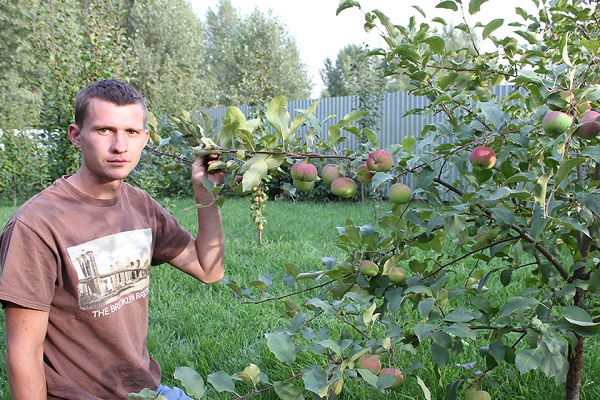
All care measures must be carried out in accordance with all the rules and in due time. Otherwise, the harvest will be less.
Tips for harvesting and storing crops
The crop is harvested during the ripening period. Summer varieties ripen in July-August, winter ones in October-November. It is important to remove the apples before the first frost, otherwise they will not stand and will become suitable only for urgent processing for juice and jam.
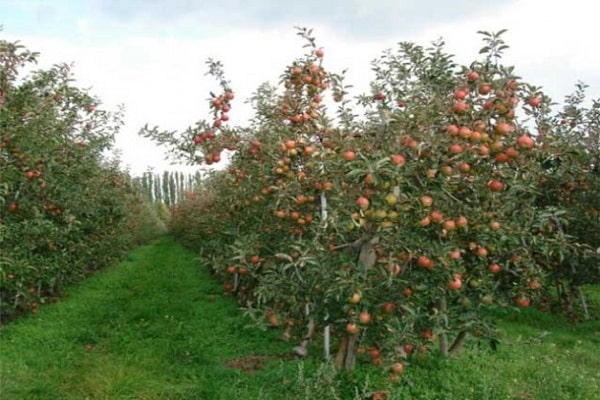
Harvesting from half-dwarfs is easy, no bulky ladders are required. If the apple trees have been properly pruned since spring, the apples can be picked directly from the ground. In extreme cases, a small stepladder is sufficient.
Here are some tips for storing crops:
- The collected apples are kept in boxes or baskets. It is important for them that there is air access, otherwise they will suffocate and begin to rot.
- Before putting the apples for storage, they must be sorted out. Spoiled, hammered and punctured skin is separated to the side, they must be processed immediately.
- Wormy apples may last longer, but they are also best separated and used earlier. Otherwise, live larvae will continue to spoil the apple.
- The crop is stored in a basement or special refrigerators. The main condition is that the room should be dry and cool, but not cold.
- There should be no extraneous odors in the storage; apples quickly draw them into themselves.
- If apples are few, they can be stored in a closet or cold room at home.If there is a risk that they may freeze, they are covered with old blankets.
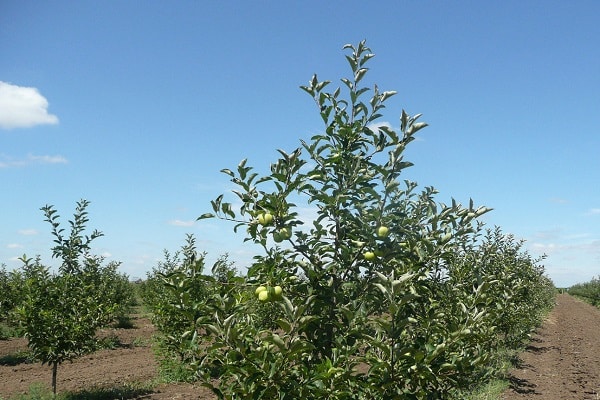
When stored properly, you can keep fresh apples until the next harvest.
Distribution regions
Semi-dwarf apple trees are widespread. They can be found in the regions of the Moscow region or Siberia. Quite widespread in the south. It all depends on the winter hardiness of the variety and its resistance to drought and disease.
